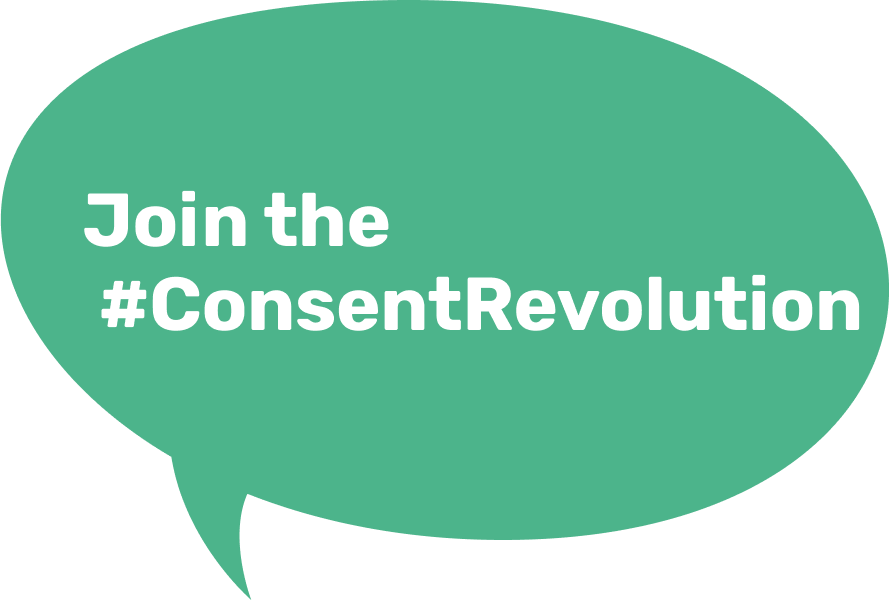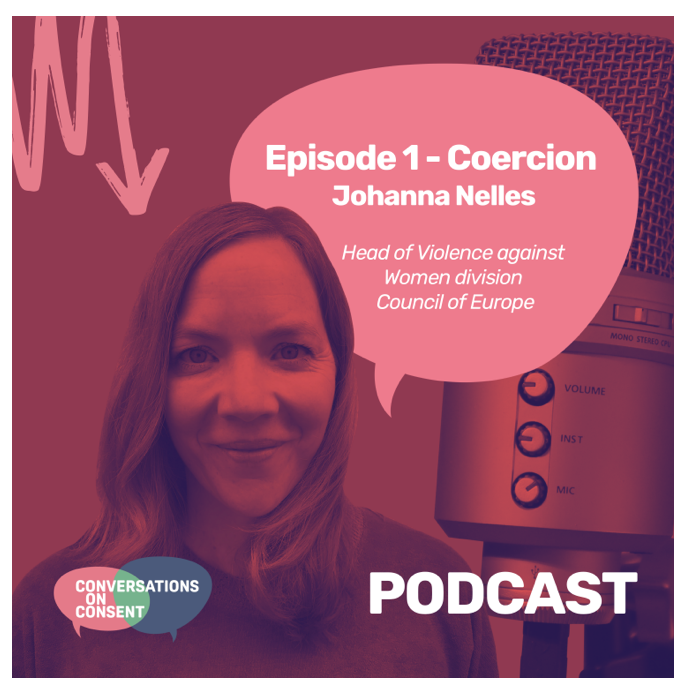Coercion
COERCION & CONSENT
Join the conversation on:
COERCION & CONSENT
Featuring Johanna Nelles (Council of Europe)
Johanna Nelles, Head of Violence against Women division at the Council of Europe, has a philosophical and legal conversation on consent, coercive circumstances and the Istanbul Convention.
Key Terms and Definitions
Here we clarified key terms and definitions to understand the topic better.
“Sexual coercion is unwanted sexual activity that happens when you are pressured, tricked, threatened, or forced in a nonphysical way.”
According to the UN, “Bodily autonomy means that we have the power and agency to make choices over our bodies and futures, without violence or coercion”.
There are three factors that shape power: knowledge, networks and resources. Actors should consider these factors to gain or maintain power. When assessing power dynamics within relationships the access of these elements of one actor need to be assessed in relation to the other actor(s) to understand their possession of the power to one another.
The Council of Europe Convention on preventing and combating violence against women and domestic violence (“the Istanbul Convention”) is a human rights treaty to prevent and combat violence against women and domestic violence. It was signed in 2011 in Istanbul by 45 countries and by the European Union and is based on four pillars: four pillars: prevention, protection, prosecution, and coordinated policies.
Did you know… ?
Here are facts and figures on the topic.
Approximately one in four women reports coerced sex. More than a third were 15 years old or younger when they first had their coerced sexual experience.
In 2020, 12 out of 31 European countries had laws that define rape based on the absence of consent. The remaining 19 European countries still haven’t included consent in their definition of rape.
The European Commission’s survey in 2016 revealed that “almost one-third of respondents considered that sexual intercourse without consent may be justified” because of the tendency to assume people who are drunk, under the influence of drugs, who don’t say ‘no’ have consent.
All member states of the European Union set a minimum age for consensual sex. It varies from 14 to 16 years, except for Malta who set it at 18 years.
Want to help spread the word? Share our animation on COERCION
Here are a few quick facts and some easy to understand information on this topic. Feel free to post to your social media accounts to get your friends involved.
Share now:
Coercion Resources
Check out the following resources to learn more about the Istanbul Convention, sexual violence, consent and coercion.
I may destroy you
TV SERIES
To understand the nuances of coercion and consent “I may destroy you” is a great way to understand various facets of the topic.
Tea Consent
YOUTUBE CHANNEL
The tea consent video shows how much consent has to do with human interaction and that consent seeking is not just applicable to the sexual realm.
No
PODCAST EPISODE
“No” presents radio-maker Kaitlin Prest’s experience on understanding the concept of sexual consent and how to communicate about it.
Metoomanyvoices
INSTAGRAM ACCOUNT
The MeTooManyVoices Community supports survivors and supporters of survivors through content by credentialed survivor advocates & educators.
Istanbul Convention Article 36
INTERNATIONAL CONVENTION
Article 36 emphasizes the importance of consent in the Istanbul Convention. Consent is not defined, but Article 36 indicates that “Consent must be given voluntarily as the result of the person’s free will assessed in the context of the surrounding circumstances.”
Myth Busters
Coercion and consent are topics that are often misunderstood because of the myths surrounding them, here we want to clean up some of the most prominent misconceptions.
How to…
Check out these guidelines that help you to have conversations on consent.
…understand whether consent is freely given:
Advice: To understand if your partner really seeks consent, you can observe your partner’s behaviour after saying ‘no’ and factor in the power dynamics between you.
…make sure that consent is an ongoing process:
Advice: Don’t forget that consent is specific for each action in consideration of a changing context. You need to have conversations on consent for each action and situation individually.
…date taking consent into consideration:
Advice: Going on a date with someone never means consent for other interactions. Going on a date with someone, going home with them, or having had a previous sexual relationship do not necessarily mean that consent to sex has been given on the occasion in question.
Coercion and Consent Cases
Here we highlight prominent cases.
Aziz Ansari and “Grace” (pseudonym)
CASE:
As reported by the survivor herself, “Grace” (not her real name) met Aziz Ansari at a party, where they exchanged numbers. A few days later, they arrange to go on a date, where she first meets him at his place and then they later go out to an expensive restaurant, where she describes him as rushing through dinner, before bringing her back to his apartment. The pair started kissing, and Ansari proceeds to pressure her for sex in various ways, ignoring her nonverbal cues. She eventually says no to his proposition of having sexual intercourse and leaves his apartment.
ANALYSIS: The story is an interesting example of how power dynamics can act as coercive measures, and why consent seeking needs to be an ongoing process in interactions, as consenting to one act does not indicate that the person consent to all following acts.

Salma Hayek and Harvey Weinstein
CASE:
The New York Times reported about Salma Hayek’s experience of repeated sexual harassment and bullying by Harvey Weinstein, a former film producer. In 2002, while making the movie Frida, Hayek was requested to take a shower with Weinstein, offered oral sex, and she had to suffer from uninvited and surprise visits to her hotel room. The tactics used by Weinstein started with sweet talks and eventually finalized with life-threatening attacks. Even though Hayek refused him each time, Weinstein threatened Hayek to cancel the movie if she hadn’t said “yes” to full naked scenes. Hayek had to show full-frontal nudity in the movie.
Because dozens of women accused Weinstein of rape, he was arrested and charged with rape in 2018.
ANALYSIS:
Due to the fact that there is a distinct power dynamic between a film producer and an actress, consent to sexual activity cannot be given freely. Freely given agreement is an important part that constitutes consent.

Know Your Rights
Enshrining consent into the law is a process that is picking up speed globally. In 2011, the Istanbul Convention on preventing and combating violence against women and domestic violence was adopted by the Council of Europe Committee of Ministers. This important international convention emphasises the importance of consent.
Interpretations of Consent and Coercion
There is no one way to implement consent-based laws. Here is an overview of different approaches in Europe alone. Briefly stated, consent in some countries is still geared towards understanding what the victim said such as “yes means yes’ ‘ approaches or “no means no” approaches. In other countries, a more contextual analysis of the situation is used. Some also take a relational approach which emphasises the obligations a party has to ensure they have proper consent before touching someone else.
Breaking Resistance
Breaking resistance is one of the oldest forms of assessing whether a rape has taken place and includes a physical fight besides the forced sex.
Breaking resistance is not in line with consent-based laws and not a good measure in order to determine rape, as it fails to take into account coercive measures that do not rely on physical violence as a way to force the survivor into sexual acts. Moreover, there are a variety of reasons why a victim might not be able to fight back while being raped. For instance, one of the trauma responses to sexual violence is “freeze mode” whereby a victim of rape will not physically resist. So, signs of physical violence can not be a good indicator of whether rape has been committed.
Unfortunately, many countries are not using consent-based definitions in their laws.
Country: Hungary
Signature: Did not sign the Istanbul Convention
Text: The Criminal Code, Section 197 defines rape as “violent sexual intercourse”, a force or threat to a person who cannot defend himself/herself and who cannot express his/her will. The criminal code is not aligned with the Council of Europe Convention as Hungary hasn’t ratified it yet
Rape Law: Criminal Code of the Republic of Hungary (2012), Section 197
No means No
The no means no approach is focusing on a verbal disagreement.
Assessing the no of a victim in determining whether a sexual assault took place removes the spotlight from the perpetrator. In some instances, the victim is not able to say no or to say anything at all, but under the “no means no” approach if they have not voiced their opposition they are treated as having consented.
Country: Germany
Date of Signature: 11 May 2011
Date of Ratification: 12 October 2017
Date of entry into force: 1 February 2018
Text: Currently the law will take both physical and verbal cues from the victim to prove lack of consent which would lead to a case of rape. The law was changed because of the “NeinHeisstNein” (No means No) campaign in response to the events during New Year’s 2015/20016 in Cologne.
Yes means Yes
The yes means yes approach is focusing on a verbal agreement.
Assessing the yes of a victim of sexual assault removes the spotlight from the perpetrator. The approach fails to ensure the “yes” of the victim reflects a genuine desire for the act to take place. In some instances, the victim says yes out of fear or as a result of deception. The “yes means yes” approach also does not allow respect for the subtlety of a victim’s wishes, particularly where the victim attaches conditions to their consent. They may, for example, agree to sexual intercourse, but only if a condom is worn. Equally, victims can say yes in circumstances they are unaware of that are against their own best interest or to say anything at all.
Country: Sweden
Date of signature: 11 May 2011
Date of ratification: 1 July 2014
Date of entry into force: 1 November 2014
Text: In 2013, the final verdict in a trial (the judge cleared “bottle sex” men of rape), a national movement called FATTA (“Get It”) started. In 2018, in alignment with #MeToo campaign, new legislation was passed to clear that non-consensual sex is rape. Rape conviction rose 75% after the law passed.
Contextual Analysis
An approach focusing on the contextual analysis of a situation factors in the surrounding circumstances and whether the defendant has proof that consent has been given. This focuses on asking whether the defendant had good reason to think there was consent, rather than whether the victim had made their lack of consent clear. It also considers whether the behavior of the defendant prior to the sexual encounter was seeking to enable the victim to provide proper consent or was an attempt to coerce, deceive or manipulate them into giving consent.
Identifying rape requires an analysis of the surrounding circumstances in order to understand the behaviour of the complainant and is endorsed by this campaign.
Country: Malta
Date of Signature: 21 May 2012
Date of Ratification: 29 July 2014
Date of entry into force: 1 November 2014
Text: Following a major overhaul to rape laws in 2018, the need to prove violence was replaced with the need to prove that consent was given. Prison sentences were also boosted from six to twelve years.
Rape Law: Article 198 in Chapter Nine of Malta’s Criminal Code
We are evolving as we share
Let us know about your comments and feedback on the information provided on our website. Is there anything to be added or adjusted? Simply contact us.

Stay up to date with the latest podcasts, new resources, and progress with our petition.





